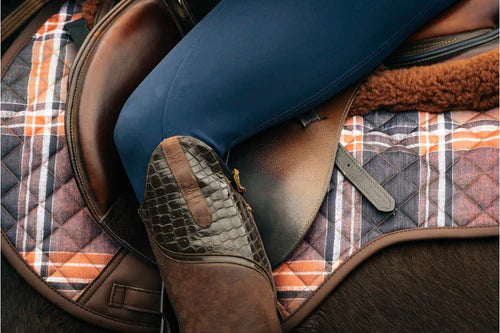Summer Skin Conditions and Fungal Infections in Horses: Identification, Treatment, and Prevention
As summer arrives, horse owners must be particularly vigilant about their horses' skin health. Warm temperatures and high humidity favor the development of several equine skin conditions, including scratches and rain rot, as well as fungal infections (Mycoses). This comprehensive blog explores these conditions and reviews available over-the-counter treatments that can help keep these highly irritating conditions at bay.
Scratches (Pastern Dermatitis)

Overview: Scratches, or pastern dermatitis, affects horse's, and foal's lower limbs, including the heel, back of the pasterns, and occasionally the cannon bone. Also know as “mud fever” or “dew poisoning”, clinical signs of Scratches include inflammation, scabbing, and cracking of the skin. If not treated promptly, Scratches can lead to severe discomfort and lameness.
Causes:
- Prolonged exposure to wet grass or mud.
- Wet bedding
- Bacterial or fungal infections (Mycoses).
- Sensitivity to certain insects, plants or chemicals.
Symptoms:
- Redness, swelling and/or heat in the pastern area.
- Scabs and crusty lesions.
- Hair loss.
- Oozing or bleeding from the affected area.
- Lameness in severe cases.
Treatment: Treating scratches involves addressing both the bacterial or fungal infection and the environmental circumstances contributing to the condition. Limiting your horse’s, or foals exposure to wet pastures and keeping their stalls clean and dry will be beneficial. In horses with long pastern hair, gently clipping the affected area will help to combat moisture. Gently wash the area with antibacterial shampoo (Betadine or Chlorhexidine) or an antifungal shampoo (Banixx Shampoo) and gently towel dry. Several over-the-counter treatments are available to help with scratches as well. Some of our favorite over-the-counter Scratches treatments include:
- Equiderma Zinc Oxide Paste:
- Description: Antibacterial, anti-dermatophyte and antifungal agents form a water-resistant barrier against the skin.
- Application: For best results wash the affected area thoroughly with Equiderma Neem Shampoo. Leave on for 10 minutes then rinse and dry thoroughly. Gently remove any loose scabs. Apply a thin layer of Equiderma Zinc Oxide Paste and leave on. Repeat every day until no more scabs or inflammation is present.
- Benefits: Sticks to the hair and skin for longer lasting protection, creating a healthy environment for healing to take place.
- Shapley's M-T-G:
- Description: An oil-based solution that combines multiple active ingredients to address a variety of skin diseases and coat conditions. M-T-G is known for its distinctive odor and slightly viscous texture, which helps it adhere to your horse's skin and hair.
- Application: Apply directly to the affected area after cleaning. Shake well to ensure that all the ingredients are mixed and apply with a soft cloth or towel. Use daily, or as recommended, until the affected area improves.
- Benefits: Effective in treating a variety of skin diseases such as rain rot, scratches, sweet itch, mud fever, and other bacterial and fungal infections, as well as promoting hair growth. Provides relief from itching and can be used as a general grooming aid to maintain a healthy mane, tail, and coat.
Rain Rot (Rain Scald)

Overview: Rain rot, also known as rain scald or dermatophilosis, is caused by the dormant bacterium Dermatophilus congolensis, which thrives in warm, wet conditions. When exposed to moisture, this bacterium can cause an inflammatory infection resulting in skin lesions. These lesions produce scabs that when removed, leave bald patches along the affected areas. In serious cases, these ulcerative lesions can affect multiple layers of your horse’s skin. If not treated, rain rot can easily spread along your horse’s, or foal's back, legs and even face. A skin biopsy may also be necessary in severe cases that don't respond to treatment.
Causes:
- Prolonged exposure to rain, high humidity and/or high temperatures.
- Horses with lighter hair color are more prone to develop rain rot due to their unpigmented skin.
- Compromised immune systems.
- Horses with existing skin irritations.
Symptoms:
- Scabs and crusty lesions, often in a pattern that follows the direction of hair growth.
- Matted hair that can be easily pulled off, revealing raw skin underneath.
- Pain and discomfort when touched.
Treatment: Treating rain rot involves keeping the horse dry, clean and groomed with gentle currying, along with using appropriate topical treatments:
- Equiderma Skin Lotion:
- Description: A soothing skin lotion designed specifically for treating equine rain rot, scratches, and other skin infections.
- Application: For best results wash the affected area thoroughly with Equiderma Neem Shampoo, rise and dry before applying Equiderma Skin Lotion. Apply to the affected area and leave it on without rinsing. Repeat daily until symptoms improve.
- Benefits: Provides quick relief from itching and pain, promotes healing, and contains soothing ingredients like aloe vera.
- Coat Defense Preventative Powder:
- Description: A powder-based treatment that helps manage moisture, sooths itchy, inflamed skin and supports the healing of multiple skin conditions.
- Application: Sprinkle the powder onto the affected area after cleaning and drying your horse's skin. Can be used daily and as a dry bath.
- Benefits: Absorbs moisture, prevents fungal and bacterial growth, and is easy to apply without the mess of creams or ointments.
Ringworm (Dermatophytosis):

Overview: Ringworm is caused by dermatophytes, a fungi that feeds on keratin in the horse's skin, hair, and hooves. Cinical signs of Ringworm include an itchy, circular pattern of hair loose that can be accompanied by a rash. Ringworm often appears on areas where your tack rubs (girth, saddle), but can spread to other areas. It is highly contagious.
Causes:
- Ringworm is usually caused by Trichophyton or Microsporum fungi, which thrive in wet weather.
- Direct contact with an infected horse.
- Indirect contact through contaminated grooming tools, tack, or stable surfaces.
Symptoms:
- Often circular patches of hair loss.
- Scaly, crusty skin lesions.
- Itching and discomfort.
- Early signs of Ringworm may not be obvious, so please contact your vet if you are unsure as it is so contagious.
Treatment: By treating Ringworm early, spread to other horses can be minimized. Be sure to clean and disinfect all equipment and surfaces that infected horse's has come into contact with to prevent reinfection. Our favorite topical antifungal treatments include:
- E3 Antibacterial/Antifungal Shampoo:
- Description: A gentle, medicated shampoo that relieves itching, irritation and skin infections. Fortified with NanoEncapsulated Vitamins A, C, E & F.
- Application: With ample water apply shampoo liberally onto your horse's coat until lathered. Let sit 5 - 10 minutes, then rise thoroughly.
- Benefits: Effective on ringworm, rain rot, seborrhea, and skin rashes.
- Banixx Horse & Pet Care:
- Description: A steroid free, topical antimicrobial spray effective against both bacterial and fungal infections..
- Application: Clean the affected area thoroughly before applying twice daily. It is non-toxic and does not sting, making it suitable for sensitive skin.
- Benefits: Rapid relief from inflammation and infection, easy to apply and no strong odor.
White Line Disease (Seedy Toe)

Overview: White Line Disease (sometimes referred to as Seedy Toe) is an opportunistic anaerobic bacteria that invades the white line in horse's hooves, eating away the internal tissue and creating pockets of ongoing infection.
Causes:
- Moisture accumulation in the hoof which leads to hoof softening, allowing the entry of dirt, fungi and bacteria.
- Mechanical stressors to the hoof including injury, abnormal loading patterns or poor hoof conformation, especially long toe/low heel conformation or club foot.
- Nutritional deficiencies which can lead to brittle hooves.
Symptoms:
- Tender soles or slight heat in the horse's hooves during the early stages.
- Flattening sole in the area of separation.
- As the separation deepens, the area may become filled with grey/white powdery hoof material indicative of damaged tissue.
- Increased susceptibility to hoof abscesses and bacterial and debris accumulate in the separated areas of the horse's hoof.
- Changes in hoof conformation.
Treatment: Treating white line disease involves your farrier removing as much of the affected area as possible Topical treatments with antimicrobial properties can provide supportive therapy to encourage new, healthy hoof growth.
- Equiderma Thrush & White Line Treatment:
- Description: The ingredients within this formula are specifically designed to attack the bacteria and fungal infections that cause thrush and white line disease.
- Application: Scrub the hoof thoroughly with Equiderma Neem Shampoo to remove all dirt and debris. Rinse well and towel dry. Apply to a clean hoof and scrub in with the brush end of the hoof pick.
- Benefits: This broad-spectrum formula works quickly, predictably, reliably, and painlessly.
- Copper-Cure Paste:
- Description: An all natural, topical solution containing copper sulfate, known for its antifungal agents and antibacterial properties.
- Application: Pick hoof and clean all dirt and debris. Pack generously into the holes, cracks, around the frog and bulbs of heel and wrap hoof with cellophane or vet wrap to make sure paste has time to absorb up into the horse's hoof. Repeat every day for severe cases and use two times a week for maintenance.
- Benefits: Effective against a broad range of pathogens, helps to dry out moist lesions, and promotes healing.
Sweet Itch (Summer Itch)

Overview: Sweet itch, also known as summer itch, is an allergic reaction to the bites of Culicoides midges (biting gnats or no-see-ums). It is a seasonal condition that causes intense itching and discomfort. Affected horses are sensitive to the irritants in midge saliva, which causes a localized irritation within the skin. The itchiness due to sweet itch is often worse in hot humid weather.
Causes:
- Bites from Culicoides midges.
- Allergic reaction to the midge saliva.
- Genetic predisposition in some horses, especially ponies.
Symptoms:
- Intense itching, leading to excessive scratching.
- Hair loss and sores, particularly along the mane, tail, and belly.
- Thickened, scaly skin.
- Behavioral changes due to discomfort.
Treatment: Managing sweet itch involves both preventing midge bites and soothing the horse’s skin. Performing medicated treatments regularly prevents midge bites, helping to stall the itch/scratch cycle and helps resolve secondary skin infections.
- Coat Defense Trouble Spot Drying Paste:
- Description: An all-natural, safe and effective solution that can help speed the healing of multiple equine skin ailments as well as sooth the itch caused by insect bites and sweet itch.
- Application: Prior to application, gently clean any dirt or debris from the treatment area. DO NOT pick off any existing scabs. Allow scabs to fall off on their own with Paste. Using fingertips, scoop paste from container, and spread thickly over treatment area. Spread as if covering bread with peanut butter to surrounding areas and down to the skin. Do not rub in. Let paste dry to a near white shell and leave on for several days.
- Benefits: Non-toxic, Talc free and USEF & FEI compliant.
- Shapley's M-T-G:
- Description: An oil-based solution that combines multiple active ingredients to address a variety of skin and coat conditions. M-T-G is known for its distinctive odor and slightly viscous texture, which helps it adhere to the horse's skin and hair.
- Application: Apply directly to the affected area after cleaning. Shake well to ensure that all the ingredients are mixed and apply with a soft cloth or towel. Use daily, or as recommended, until the affected area improves.
- Benefits: Effective in treating a variety of skin ailments such as rain rot, scratches, sweet itch, mud fever, and other fungal organisms and bacterial infections, as well as promoting hair growth. Provides relief from itching and can be used as a general grooming aid to maintain a healthy mane, tail, and coat.
Measures to Prevent Summer Skin Conditions, Ringworm and Fungal Diseases of Horses
To prevent these skin conditions and infections, horse owners should adopt the following practices:
1. Maintain Clean Stables:
- Regularly clean and disinfect stables, especially during warm and humid weather.
2. Proper Grooming:
- Groom horses regularly to remove dirt and sweat, which can harbor fungal spores.
- Avoid sharing grooming tools and tack between horses.
3. Monitor the Environment:
- Ensure good ventilation in stables for healthy horses.
- Store hay and bedding in dry, well-ventilated area to prevent mold growth.
4. Boost Immune Health:
- Provide a balanced diet rich in vitamins and minerals to support you horse's immune system.
- Regular exercise and reducing stress can also enhance overall health and resistance to infections.
5. Quarantine New Arrivals:
- Isolate new horses for a period to monitor for any signs of infection before introducing them to the herd.
Scratches, rain rot, fungal diseases and bacterial infections are common equine skin conditions during the summer, but with prompt identification and appropriate treatment, horses and foals can recover quickly. Over-the-counter treatments can offer effective solutions for managing and healing these conditions. However, if your horse's condition does not improve or worsens, please contact your veterinarian immediately as veterinary medicine, such as antifungal drugs, may be needed. Preventive measures such as maintaining a clean environment, proper grooming, and supporting immune health are crucial in reducing the risk of infections. By staying vigilant and proactive, horse owners can ensure their equine partners remain healthy and comfortable throughout the summer months.





